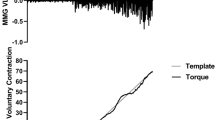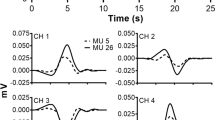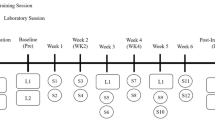Abstract
Purpose
Previous investigations analyzing resistance training’s influence on motor unit (MU) firing rates have yielded mixed results. These mixed results may be clarified by concurrently measuring changes in MU size. Thus, this study analyzed whether post-training strength gains were due to increases in MU firing rates and/or sizes as measured indirectly via action potential amplitudes.
Methods
Sixteen males (age = 20.7 ± 1.9 years) completed 8 weeks of resistance training, while eight males (age = 19.4 ± 2.5 years) served as controls. Vastus lateralis surface electromyography signals collected during submaximal isometric knee extensions were decomposed to yield an action potential amplitude (MUAPAMP), mean firing rate (MFR), and recruitment threshold (RT) for each MU. Each contraction’s average MFR and MUAPAMP, and coefficients of the linear (y-intercept and slope) MUAPAMP-RT, linear MFR-RT and exponential (A and B terms) MFR–MUAPAMP relationships were analyzed. Firing instances and action potentials were validated via reconstruct-and-test and spike-triggered averaging procedures. Vastus lateralis cross-sectional area (CSA) was analyzed with ultrasonography.
Results
Resistance training increased isometric strength from 204.6 ± 34.9 to 239.8 ± 36.3 Nm and vastus lateralis CSA from 28.7 ± 4.7 to 34.0 ± 5.0 cm2. Resistance training did not affect MFR–RT relationship parameters or average MFRs but did increase the slopes of the MUAPAMP–RT relationships (0.0067 ± 0.0041 to 0.0097 ± 0.0045 mV/%MVC) and average MUAPAMPs from 0.189 ± 0.093 to 0.249 ± 0.127 mV. MU hypertrophy altered the MFR–MUAPAMP relationships (B terms: − 3.63 ± 1.40 to − 2.66 ± 1.38 pps/mV).
Conclusion
Resistance training induced MU and muscle hypertrophy, but did not alter firing rates. Greater MU twitch forces resulting from larger MUs firing at pre-training rates likely explain resistance training strength gains.






Similar content being viewed by others
Abbreviations
- ANOVA:
-
Analysis of variance
- CSA:
-
Cross-sectional area
- EMG:
-
Electromyography
- MFR:
-
Mean firing rate
- MU:
-
Motor unit
- MUAPAMP :
-
Motor unit action potential amplitude
- MVC:
-
Maximal voluntary contraction
- PDIII:
-
Precision decomposition III
- RT:
-
Recruitment threshold
- STA:
-
Spike-triggered averaging
References
Balshaw TG, Massey GJ, Maden-Wilkinson TM, Morales-Artacho AJ, McKeown A, Appleby CL, Folland JP (2017) Changes in agonist neural drive, hypertrophy and pre-training strength all contribute to the individual strength gains after resistance training. Eur J Appl Physiol 117(4):631–640. https://doi.org/10.1007/s00421-017-3560-x
Beck TW, J.M. D, M.S. S (2011) The effects of a resistance training program on average motor unit firing rates. Clin Kinesiol (65):1–8
Bottinelli R, Schiaffino S, Reggiani C (1991) Force-velocity relations and myosin heavy chain isoform compositions of skinned fibres from rat skeletal muscle. J Physiol 437:655–672
Burke RE, Levine DN, Zajac FE 3rd (1971) Mammalian motor units: physiological-histochemical correlation in three types in cat gastrocnemius. Science 174(4010):709–712
Carolan B, Cafarelli E (1992) Adaptations in coactivation after isometric resistance training. J Appl Physiol 73(3):911–917. https://doi.org/10.1152/jappl.1992.73.3.911
Chang SS, De Luca CJ, Nawab S (2008) Aliasing rejection in precision decomposition of EMG signals. Conf Proc IEEE Eng Med Biol Soc 2008:4972–4975. https://doi.org/10.1109/IEMBS.2008.4650330
Colquhoun RJ, Magrini MA, Haun CT, Muddle TWD, Tomko PM, Luera MJ, Mackey CS, Vann CG, Martin JS, Young KC, DeFreitas JM, Roberts MD, Jenkins NDM (2018) Muscle phenotype is related to motor unit behavior of the vastus lateralis during maximal isometric contractions. Physiol Rep 6(5). https://doi.org/10.14814/phy2.13636
Contessa P, De Luca CJ, Kline JC (2016) The compensatory interaction between motor unit firing behavior and muscle force during fatigue. J Neurophysiol 116(4):1579–1585. https://doi.org/10.1152/jn.00347.2016
Damas F, Libardi CA, Ugrinowitsch C, Vechin FC, Lixandrao ME, Snijders T, Nederveen JP, Bacurau AV, Brum P, Tricoli V, Roschel H, Parise G, Phillips SM (2018) Early- and later-phases satellite cell responses and myonuclear content with resistance training in young men. PLoS ONE 13(1):e0191039. https://doi.org/10.1371/journal.pone.0191039
De Luca CJ, Erim Z (1994) Common drive of motor units in regulation of muscle force. Trends Neurosci 17(7):299–305
De Luca CJ, Hostage EC (2010) Relationship between firing rate and recruitment threshold of motoneurons in voluntary isometric contractions. J Neurophysiol 104(2):1034–1046. https://doi.org/10.1152/jn.01018.2009
De Luca CJ, Adam A, Wotiz R, Gilmore LD, Nawab SH (2006) Decomposition of surface EMG signals. J Neurophysiol 96(3):1646–1657. https://doi.org/10.1152/jn.00009.2006
Del Vecchio A, Casolo A, Negro F, Scorcelletti M, Bazzucchi I, Enoka R, Felici F, Farina D (2019) The increase in muscle force after 4 weeks of strength training is mediated by adaptations in motor unit recruitment and rate coding. J Physiol. https://doi.org/10.1113/JP277250
Dimmick HL, Miller JD, Sterczala AJ, Trevino MA, Herda TJ (2018) Vastus lateralis muscle tissue composition and motor unit properties in chronically endurance-trained vs. sedentary women. Eur J Appl Physiol. https://doi.orrg/10.1007/s00421-018-3909-9
Eddinger TJ, Moss RL (1987) Mechanical properties of skinned single fibers of identified types from rat diaphragm. Am J Physiol 253(2 Pt 1):C210–218
Enoka RM, Duchateau J (2015) Inappropriate interpretation of surface EMG signals and muscle fiber characteristics impedes understanding of the control of neuromuscular function. J Appl Physiol 119(12):1516–1518. https://doi.org/10.1152/japplphysiol.00280.2015
Erskine RM, Fletcher G, Folland JP (2014) The contribution of muscle hypertrophy to strength changes following resistance training. Eur J Appl Physiol 114(6):1239–1249. https://doi.org/10.1007/s00421-014-2855-4
Farina D, Holobar A, Merletti R, Enoka RM (2010) Decoding the neural drive to muscles from the surface electromyogram. Clin Neurophysiol 121(10):1616–1623. https://doi.org/10.1016/j.clinph.2009.10.040
Farina D, Merletti R, Enoka RM (2014) The extraction of neural strategies from the surface EMG: an update. J Appl Physiol 117(11):1215–1230. https://doi.org/10.1152/japplphysiol.00162.2014
Gabriel DA, Kamen G, Frost G (2006) Neural adaptations to resistive exercise: mechanisms and recommendations for training practices. Sports Med 36(2):133–149
Hakansson CH (1956) Conduction velocity and amplitude of the action potential as related to circumference in the isolated fibre of frog muscle. Acta Physiol Scand 37(1):14–34. https://doi.org/10.1111/j.1748-1716.1956.tb01338.x
Helms ER, Cronin J, Storey A, Zourdos MC (2016) Application of the repetitions in reserve-based rating of perceived exertion scale for resistance training. Strength Cond J 38(4):42–49. https://doi.org/10.1519/SSC.0000000000000218
Henneman E, Olson CB (1965) Relations between structure and function in the design of skeletal muscles. J Neurophysiol 28:581–598
Herda TJ, Trevino MA, Sterczala AJ, Miller JD, Wray ME, Dimmick HL, Gallagher PM, Fry AC (2019) Muscular strength and power are correlated with motor unit action potential amplitudes, but not myosin heavy chain isoforms in sedentary males and females. J Biomech 86:251–255. https://doi.org/10.1016/j.jbiomech.2019.01.050
Hu X, Rymer WZ, Suresh NL (2013a) Assessment of validity of a high-yield surface electromyogram decomposition. J Neuroeng Rehabil 10:99. https://doi.org/10.1186/1743-0003-10-99
Hu X, Rymer WZ, Suresh NL (2013b) Motor unit pool organization examined via spike-triggered averaging of the surface electromyogram. J Neurophysiol 110(5):1205–1220. https://doi.org/10.1152/jn.00301.2012
Hu X, Rymer WZ, Suresh NL (2013c) Reliability of spike triggered averaging of the surface electromyogram for motor unit action potential estimation. Muscle Nerve 48(4):557–570. https://doi.org/10.1002/mus.23819
Jenkins NDM, Miramonti AA, Hill EC, Smith CM, Cochrane-Snyman KC, Housh TJ, Cramer JT (2017) Greater neural adaptations following high- vs low-load resistance training. Front Physiol 8:331. https://doi.org/10.3389/fphys.2017.00331
Kamen G, Knight CA (2004) Training-related adaptations in motor unit discharge rate in young and older adults. J Gerontol A Biol Sci Med Sci 59(12):1334–1338
Knight CA, Kamen G (2001) Adaptations in muscular activation of the knee extensor muscles with strength training in young and older adults. J Electromyogr Kinesiol 11(6):405–412
Martinez-Valdes E, Laine CM, Falla D, Mayer F, Farina D (2016) High-density surface electromyography provides reliable estimates of motor unit behavior. Clin Neurophysiol 127(6):2534–2541. https://doi.org/10.1016/j.clinph.2015.10.065
McManus L, Hu X, Rymer WZ, Lowery MM, Suresh NL (2015) Changes in motor unit behavior following isometric fatigue of the first dorsal interosseous muscle. J Neurophysiol 113(9):3186–3196. https://doi.org/10.1152/jn.00146.2015
Miller JD, Sterczala AJ, Trevino MA, Wray ME, Dimmick HL, Herda TJ (2019) Motor unit action potential amplitudes and firing rates during repetitive muscle actions of the first dorsal interosseous in children and adults. Eur J Appl Physiol. https://doi.org/10.1007/s00421-019-04090-0
Moritani T, deVries HA (1979) Neural factors versus hypertrophy in the time course of muscle strength gain. Am J Phys Med 58(3):115–130
Nawab SH, Chang SS, De Luca CJ (2010) High-yield decomposition of surface EMG signals. Clin Neurophysiol 121(10):1602–1615. https://doi.org/10.1016/j.clinph.2009.11.092
Olson CB, Carpenter DO, Henneman E (1968) Orderly recruitment of muscle action potentials. Arch Neurol 19(6):591–597
Patten C, Kamen G, Rowland DM (2001) Adaptations in maximal motor unit discharge rate to strength training in young and older adults. Muscle Nerve 24(4):542–550
Person RS, Kudina LP (1972) Discharge frequency and discharge pattern of human motor units during voluntary contraction of muscle. Electroencephalogr Clin Neurophysiol 32(5):471–483
Pope ZK, Hester GM, Benik FM, DeFreitas JM (2016) Action potential amplitude as a noninvasive indicator of motor unit-specific hypertrophy. J Neurophysiol 115(5):2608–2614. https://doi.org/10.1152/jn.00039.2016
Pucci AR, Griffin L, Cafarelli E (2006) Maximal motor unit firing rates during isometric resistance training in men. Exp Physiol 91(1):171–178. https://doi.org/10.1113/expphysiol.2005.032094
Rich C, Cafarelli E (2000) Submaximal motor unit firing rates after 8 wk of isometric resistance training. Med Sci Sports Exerc 32(1):190–196
Snijders T, Smeets JS, van Kranenburg J, Kies AK, van Loon LJ, Verdijk LB (2016) Changes in myonuclear domain size do not precede muscle hypertrophy during prolonged resistance-type exercise training. Acta Physiol (Oxf) 216(2):231–239. https://doi.org/10.1111/apha.12609
Sterczala AJ, Herda TJ, Miller JD, Ciccone AB, Trevino MA (2017) Age-related differences in the motor unit action potential size in relation to recruitment threshold. Clin Physiol Funct Imaging. https://doi.org/10.1111/cpf.12453
Sterczala AJ, Miller JD, Trevino MA, Dimmick HL, Herda TJ (2018) Differences in the motor unit firing rates and amplitudes in relation to recruitment thresholds during submaximal contractions of the first dorsal interosseous between chronically resistance trained and physically active men. Appl Physiol Nutr Metab. https://doi.org/10.1139/apnm-2017-0646
Stock MS, Thompson BJ (2014) Effects of barbell deadlift training on submaximal motor unit firing rates for the vastus lateralis and rectus femoris. PLoS ONE 9(12):e115567. https://doi.org/10.1371/journal.pone.0115567
Thompson CK, Negro F, Johnson MD, Holmes MR, McPherson LM, Powers RK, Farina D, Heckman CJ (2018) Robust and accurate decoding of motoneuron behaviour and prediction of the resulting force output. J Physiol 596(14):2643–2659. https://doi.org/10.1113/JP276153
Trevino MA, Herda TJ, Fry AC, Gallagher PM, Vardiman JP, Mosier EM, Miller JD (2016) The influence of myosin heavy chain isoform content on mechanical behavior of the vastus lateralis in vivo. J Electromyogr Kinesiol 28:143–151. https://doi.org/10.1016/j.jelekin.2016.04.005
Trevino MA, Sterczala AJ, Miller JD, Wray ME, Dimmick HL, Ciccone AB, Weir JP, Gallagher PM, Fry AC, Herda TJ (2018) Sex-related differences in muscle size explained by amplitudes of higher-threshold motor unit action potentials and muscle fibre typing. Acta Physiol (Oxf):e13151. https://doi.org/10.1111/apha.13151
Van Cutsem M, Duchateau J, Hainaut K (1998) Changes in single motor unit behaviour contribute to the increase in contraction speed after dynamic training in humans. J Physiol 513(Pt 1):295–305
Vila-Cha C, Falla D, Farina D (2010) Motor unit behavior during submaximal contractions following six weeks of either endurance or strength training. J Appl Physiol 109(5):1455–1466. https://doi.org/10.1152/japplphysiol.01213.2009
Walker S, Hulmi JJ, Wernbom M, Nyman K, Kraemer WJ, Ahtiainen JP, Hakkinen K (2013) Variable resistance training promotes greater fatigue resistance but not hypertrophy versus constant resistance training. Eur J Appl Physiol 113(9):2233–2244. https://doi.org/10.1007/s00421-013-2653-4
Watanabe K, Holobar A, Kouzaki M, Ogawa M, Akima H, Moritani T (2016) Age-related changes in motor unit firing pattern of vastus lateralis muscle during low-moderate contraction. Age (Dordr) 38(3):48. https://doi.org/10.1007/s11357-016-9915-0
Author information
Authors and Affiliations
Contributions
AJS and TJH conceived and designed research. AJS, JDM, HLD, MEW and MAT acquired and analyzed data. AJS and TJH drafted the manuscript. AJS, JDM, HLD, MEW, MAT and TJH reviewed and revised the manuscript. All authors read and approved the manuscript.
Corresponding author
Ethics declarations
Conflict of interest
The authors report no conflict of interest.
Additional information
Communicated by William J. Kraemer .
Publisher's Note
Springer Nature remains neutral with regard to jurisdictional claims in published maps and institutional affiliations.
Rights and permissions
About this article
Cite this article
Sterczala, A.J., Miller, J.D., Dimmick, H.L. et al. Eight weeks of resistance training increases strength, muscle cross-sectional area and motor unit size, but does not alter firing rates in the vastus lateralis. Eur J Appl Physiol 120, 281–294 (2020). https://doi.org/10.1007/s00421-019-04273-9
Received:
Accepted:
Published:
Issue Date:
DOI: https://doi.org/10.1007/s00421-019-04273-9




